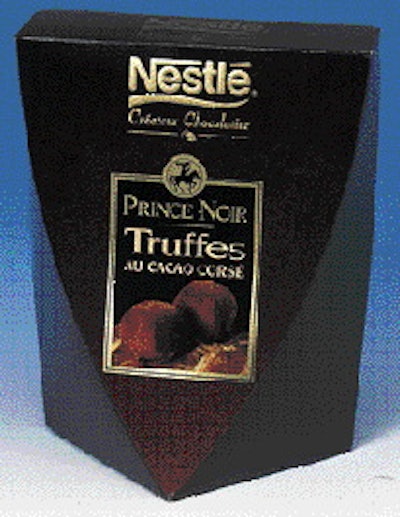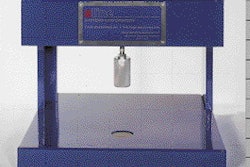In mid-morning, the Intl. Steel Packaging Congress witnessed the quickest half-hour of the day. Lars Wallentin, assistant vice president for communications at Nestl/ in Switzerland, delivered a lively audio-visual presentation titled, "'If you are not seen, you can't be bought': How to look different and still be attractive is a matter of teamwork." "Consumers behave the same, regardless of where they are," Wallentin opened. "The only products of the tens of thousands in a busy supermarket environment that have a chance to leave through the checkouts are those with outstanding product quality, those heavily supported by advertising, or those with remarkable package design." And he added that very few products, especially foods, can claim significantly superior quality. And not many are lucky to be heavily supported in the media. The fact is, he said, that most products fall into the remaining area: good to excellent quality, but with little to differentiate them from competitors, whether they be private-label, local, national or world brands. "To stand out, your package must be remarkable," the Nestl/ executive emphasized. "Here I should even prefer the French wording, 'etre remarque,' meaning to be noticed or to attract attention." Wallentin then launched into eight concepts in package design, many of them illustrated by package examples or by famous quotes rendered in his own calligraphy. But he began by telling the audience to "always surprise the consumer." Graphics techniques He explained some principles of graphics relative to shadows (create appearance of volume), converging lines (suggest distance), shapes (large appear closer than small), colors (dark appear closer than light) and contrast (creates drama). "I am not here to be your art school teacher, but these principles have been valid since humans began to draw and are as immutable as typographic truths," several of which he also cited. "Other truths are that we learn best by seeing, followed by hearing. . . It's equally true that we recognize or remember best of all colors, followed by shapes, images and words." He then showed a number of slides of packages that he felt had great graphics. But, he cautioned the audience, the products are not necessarily successes in the marketplace, because that requires a combination of price, distribution, quality, media support and, last but not least, product taste and ease of preparation or convenience. As he began to discuss illustration, the second element in a remarkable package, he warmed to the subject of foods. "The package must make the mouth water, either through an illustration or by actually showing the product [through a window, transparent plastic or glass container]. "We eat with our eyes before we put the food or drink into our mouth," he told the audience. "The illustration must have a captivating light, the food styling must be impeccable, the food ought to be in a close-up and have the right colors. That way, when we consume it, as the Chinese say, we 'shine of happiness'." He showed several examples, one including a luscious photo of peaches (above) on a cobbler package and a windowed box for pasta. Brand visuals To be seen before the competitive products, Wallentin suggested that marketers can use the brand's key visual properties to increase impact, reinforce a brand's positioning and make the package more dynamic, relevant and contemporary. A quote from legendary adman Jack Trout helped make his point: "Out of sight sure does mean out of mind!" Among examples, he showed how Kellogg's split up an illustration of Tony the Tiger over two boxes of Frosted Flakes and how a Schweppe's food product used its brand name so large it wrapped around the corners of a carton. To introduce the element of surprise, he also showed how the trademarked Toblerone package can be customized for various holidays and graphic variations for the Crunch wrapper. For creativity with colors, Wallentin cited Nivea containers and how Nestl/ uses red for chocolates. Intriguing use of text was the next principle, and Wallentin noted some winners have a product brand name that's easy to remember, like Nestl/'s Yes (see page 94) and NRG sports drink. Descriptive names can be a strong advantage, and he showed a Nestl/ redesign for a baking chocolate wrapper that went from an emphasis of the Nestl/ name to a new product name, Easy to Melt. He also noted that a product's advantage or key consumer benefit can be expressed in a youthful and unforgettable manner. To illustrate, he showed a jar of President's Choice salsa that's billed as "desperately hot." We should not forget, he stated, that consumers get older demographically, but younger mentally. Color appeal Wallentin didn't have much to say about color, except to point out that modern printing technology can reproduce just about any conceivable color, so color is no hindrance to making a statement about a brand. As examples of products that have become memorable through the use of color, he showed Cadbury's Milka in a lavender wrapper, Nestl/'s colorful Smarties pack (see page 89) and its dark and elegant Truffles (see page 94) stand-up pouch. Next in his creative list of eight is humor, which like color, is spelled with a "u" in Europe. Wallentin had a bevy of quotes from business people like The Body Shop's Anita Roddick and Virgin's Richard Branson, not to mention jazz vocalist Betty Carter and entertainer Victor Borge. "If a brand does not have a clear and simple positioning, it's very difficult to develop an outstanding and memorable package design. This has also to do with risk-taking and a lot of 'thinking outside the box,' as well as steeling (or stealing) ideas from another category." In terms of examples, he liked a slightly broken "X" for Xerox, The Document Company, and how one fragrance by a Paris designer was packaged in a shapely glass bottle that was itself packaged in a bright steel can. When he talked about interesting packaging materials contributing to a distinctive package and product, he showed some products that had shifted to flexible packaging, and he displayed two shaped steel cans for Sapporo and Carling beers. He noted that paper expresses ecology, craftsmanship, tradition, home-made or natural. What, he asked, can steel express if not "strength, coldness, refreshment, protection or long shelf life, tradition, tactile sensation, tamper-evidence, quality and beauty." In terms of shape, he reminded the congress that shape is the second-most-often recognized package characteristic. When he examined characteristic package shapes, he showed off the Carling soccer ball embossed can, Coke's contour-shaped steel can and some unusual shapes for Cadbury's Milka chocolates. "It is here we expect things to happen within steel packaging. . . However, the real breakthrough will come only when designers have learned to combine the shape of the steel container with other materials, great copy, outstanding appetite appeal, easy opening, brilliant colors and superb graphics." All of this can be achieved only by teamwork, he stressed. The ultimate result is always one of synergy, when one plus one adds up to three. Each person's specialization adds up to something new and different. And, he concluded, "this is a must if you wish your brand to be seen and bought."
























